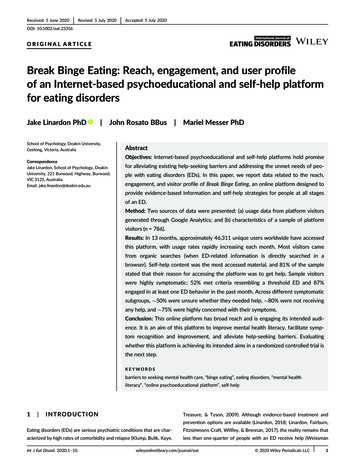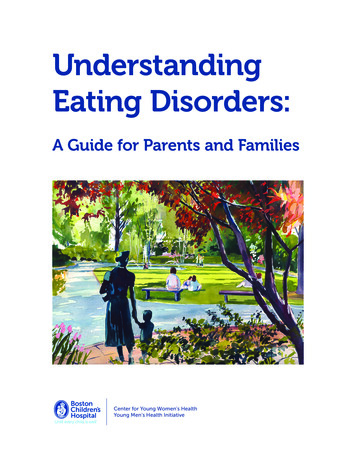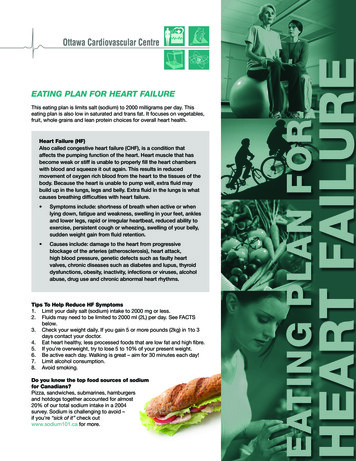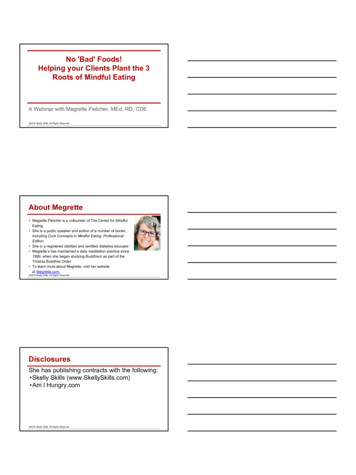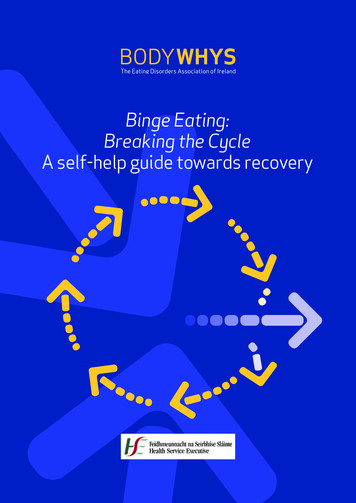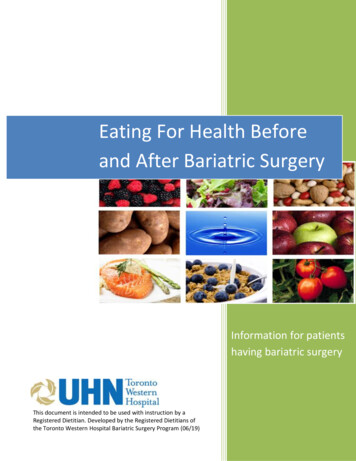
Transcription
Eating For Health Beforeand After Bariatric SurgeryInformation for patientshaving bariatric surgeryThis document is intended to be used with instruction by aRegistered Dietitian. Developed by the Registered Dietitians ofthe Toronto Western Hospital Bariatric Surgery Program (06/19)1
Table of ContentsAbout this manual. 4What a Registered Dietitian does . 6How to use a food journal . 7Your weight loss journey . 10Setting your weight loss goal . 12Learn the nutrition basics . 14How to read a Nutrition Facts table . 19Your digestive system . 26Nutrition Complications . 34Nausea, vomiting and stomach pain . 35Dehydration . 36Food intolerance . 39Lactose intolerance. 40Diarrhea . 41Constipation. 42Hypoglycemia (low blood sugar) . 43Gas . 45Dumping syndrome . 46Hair loss . 48Protein Supplements . 49Vitamin and Mineral Supplements . 52Multivitamin-mineral supplement . 53Calcium with vitamin D supplement. 54Vitamin B12 supplement . 55Planning your supplement schedule . 57Preparing for surgery: SlimTime 60 .SlimTime recipes . 62Side effects while preparing for surgery . 65How to buy SlimTime . 662
Other things to do before your surgery . 67Eating after your surgery . 69Days 1 & 2: Clear fluids . 70Weeks 1 and 2: Liquid diet 71 .Weeks 3 and 4: Pureed diet . 76Weeks 5 to 9: Soft diet . 83Lifelong healthy eating: Week 10 and beyond . 87High Protein Foods 90.How Should I Drink . 94What Should I Eat . 96Going out to eat . 107Mindful eating. 110Exercise . 116Top 10 things you can do to stay healthy . 119Helpful resources . 117‘The future you see is the future you get.’About this Manual-Robert G Allen3
Read this manual to learn how to be successful after Bariatric Surgery.These guidelines will help you: prepare for surgery recover more quickly be more successful in losing weight after surgeryWrite down any questions you might have on the next page.Bring these questions to your Registered Dietitian.Bring this manual with you to every appointmentwith your Registered Dietitian.TWH Bariatric Registered Dietitians: Laura ScottKatie WarwickKeely LoIvy LuSavannah BlackStella PaterakisPhone:416-603-5800 ext. nah.Black2@uhn.caStella.Paterakis@uhn.ca4
Write your questions here:5
What a Registered Dietitian DoesYour dietitian is here to support you while you are on your weight loss journey. They arehere to help you initially lose the weight and keep it off.Ask your dietitian questions about: food eating nutrition in generalAfter surgery, you will see a Bariatric Dietitian: at 1-month, 3-months, 6-months and 1-year year after surgery after 1-year you will be followed by your family doctor or referring physicianAsk your Registered Dietitian any nutrition questions you might have.Your Registered Dietitian is here to support you.Research has shown that patients who attend their follow-up appointments are moresuccessful. They are more likely to: reach their weight loss goal maintain their weight loss6
How to Use a Food JournalProvide a 14-day food journal when you meet with your Registered Dietitian.This will help the Registered Dietitian (RD) understand how you are eating now, andhow your eating will need to change after surgery.Tips for using a food journalThere are many food journals available, including paper, online, and smart phone apps.There is a sample journal on the next page. Start your food journal 3 weeks before your appointment with the RD. Include 14 days of intake in your food journal. Write down what you eat and drink right after you have it. Do not wait. Youmight forget. Measure your food. If you are at home, use measuring cups and spoons. If youare eating at a restaurant, compare the food to a common object with the samevolume. For example, if the chicken breast is the same size as the palm of yourhand, it is about 3 ounces. Include as much detail as you can. For example, write down the brand name ofany packaged food. For all milk products write down the fat percentage. For example, write down“1% milk” instead of just “milk”. Write down how the food was cooked. For example, write down "steamedbroccoli" instead of just "broccoli". Write down any extra added ingredients. For example, write "coffee with 1%milk" instead of just "coffee". Write down any fat or oil you used for cooking. Write down the amount and thebrand. For example, write "1 teaspoon Becel margarine” instead of just"margarine". Write down the name of the restaurant where you ate.7
Sample food journalName of foodWhat is in itFruit SmoothieBreakfast1/2 cup1/2 cup2 tablespoonsTime: 9:00am1 packetMorning snackTime: -----Turkey SandwichLunchTime: 12:30pmMilkAfternoon snackTime: -----1 slice1 teaspoon1 slice3 slices1 cupskim milk------4 ouncesboneless skinless chickenbreast, pan fried1 tbspolive oilRice1/2 cupsteamed brown riceVegetables1 cup1 tspsteamed broccolilow sodium soy sauceDinnerTime: 6:00pmEvening snackTime: --Did I take all mysupplements?--Dempsters whole wheatbreadmustardtomatoSchneiders deli Turkey--Chickenskim milkfrozen strawberrieswhey isolate proteinpowderSplenda sweetener--------- Multivitamin-mineral Calcium with vitamin D Vitamin B12 Other:How did I feel today?8
Food JournalName of foodWhat is in itBreakfastTime:Morning snackTime:LunchTime:Afternoon snackTime:DinnerTime:Evening snackTime:Did I take all mysupplements? Multivitamin-mineral Calcium with vitamin D Vitamin B12 Other:How did I feel today?9
Your Weight Loss JourneyEveryone’s weight loss journey is unique.As you begin your weight loss journey you will expect it to go a certain way. This couldbe based on what you have read online or in books, or what you have heard fromsomeone who has had the surgery.Do not compare yourself to others who have had the surgery,everyone’s weight loss journey is different.Read this section to learn how to set realistic weight loss goals.Let us compare your weight loss journey to a game of golf10
There are hazards along the waySome golfers will come across problems on the course such as water hazards or sandtraps. In the same way, some people have complications after surgery such as gallstonesor low iron.These “hazards” can make your journey more difficult, but they will not prevent youfrom reaching your goal.Do not get discouraged by small setbacks.Sometimes you will gain. Sometimes you will lose. Sometimes you will stall.On the golf course there are hills, valleys and flat ground. If we were to graph yourweight loss it may look similar and have many ups and downs and flat lines.There will be times when you are losing weight quickly. There will be other times whenyou may gain a pound or two. Your weight may also plateau or stall for days or weeks.All of this is a normal part of weight loss.Focus on your goalsStay focused on your goal and do not lose hope if your weight stalls.When you lose hope you are more likely to go back to bad habits such as using food tocope with stress or sadness. Keep following these guidelines and have faith in yourself.You will reach your weight loss goal in whatever length of time your body needs.11
Setting Weight Loss GoalsBe realistic when setting your weight loss goal.A weight loss goal does not have to be a number. It can be: A way of feelingAn activity you want to doA health condition you want to improveA clothing size you want to wearIf you decide to set a goal in pounds or kilograms, keep in mind what the research says.Research shows that on average:After 1 to 1.5 years, patients lose 60% to 85% of their excess body weight.After 5 years, patients maintain a weight loss of 50% to 60% of their excess body weight.For example, if you:1. Weigh 300lbs before surgery2. Have 150lbs of excess body weight before surgeryYou will likely lose and maintain a loss of 75lbs to 90lbs after 5 years.Remember: Your weight loss will vary depending on yourcommitment and ability to maintain a healthy diet and lifestyle.12
Write your weight loss goals here:‘Without goals, and plans to reach them, you are like a ship that hasset sail with no destination.’-Fitzhugh Dodson13
Learn the Nutrition BasicsBariatric surgery is a tool to help you lose weight.It is not a magic cure for obesity.To lose weight and maintain your weight loss you need to learn the basics of nutrition.Read this section to learn about: caloriescarbohydrateproteinfathow to read a nutrition labelWhat is a calorie?Energy is measured by kilocalories (kcal). Mostpeople just call them “calories”.People think that energy is good and caloriesare bad, but one is just a measure of the other.The number of calories in a food tells you howmuch energy that food will give you.For example, a 250 kcal chocolate bar providesenough energy for about 60 minutes of walking.14
What provides energy?There are three major nutrients in our food that give us energy in the form of calories.They are protein, fat and carbohydrate. Most food has a combination of all three majornutrients.Food also has vitamins, minerals, fibre, antioxidants and water. These other parts offood are very important for our health and well-being, but do not give us any calories.1 gram of protein provides 4 kcal of energySome examples of protein are: meat, chicken, fish and eggsmeat alternatives (tofu, beans and lentils)milk and milk alternativesnuts and seeds1 gram of fat provides 9 kcal of energySome examples of fat are: oil, butter, margarine and lardnuts and seedssalad dressingsnack foods and fried foodsfatty meatfull fat milk and milk products1 gram of carbohydrate provides 4 kcal of energySome examples of carbohydrate are: bread, pasta, cereal and grainsbeansfruit and root vegetablessugar, honey, jam and candybaked goodsNote that fat has more than twice as many calories as carbohydrate or protein. This iswhy foods high in fat are usually very high in calories.15
What is fat?Fat is an important part of our body. Our bodies need fat for many important jobs like: building cell membranes making hormonesHealthy eating includes some fat.However, when eating foods with fat, it is important to keep portions small. This willhelp prevent weight gain because fat is high in calories.After surgery, high fat foods may upset your stomach. They may also cause dumpingsyndrome.For more information on dumping syndrome see page 45.What foods are high in fat? oil butter, margarineand lard nuts and seeds milk and milkalternatives meat and fishsnack foodssalad dressingfried foodsMilk, milk alternatives and meat can be high in fat. Look for “low fat” or “light”milk and alternatives, “lean” cuts of meat, and remove skin from chicken toreduce the amount of fat in these foods.16
What is protein?Protein is a part of every cell in our body. It is used to build, maintain and repair thebody’s cells and tissues.After surgery it is very important to eat foods high in protein because: your body needs extra protein to heal your body needs protein to prevent muscle loss while you’re losing weightGetting enough protein can be a challenge because: you may not be able to digest meat very well portion sizes are smallBecause of this you will need to take protein supplements for a few months aftersurgery. For more information on protein supplements turn to page 50.What foods are high in protein? meat, chicken, fish meat alternatives(such as tofu,beans, lentils andchickpeas) nuts and seeds eggs milk and milk alternatives17
What is carbohydrate?Carbohydrates are an important source of energy and can be part of healthy eating. Notall carbohydrates are the same. Some carbohydrates, like those made with whole grains,are high in fibre and vitamins and minerals. Fibre is an important nutrient. Fibre doesnot give your body any calories. Fibre is important for regular bowel movements andkeeps you feeling full. Choose whole grain options whenever possible and avoid foodsthat are high in sugar.What foods are high in carbohydrate? breadcerealpastagrainsbeansfruitrootvegetables sugarhoneyjamcandybaked goodsHow many calories will you need after surgery?Your body is unique. Everyone needs a different number of calories. How many caloriesyou will need will change over time after surgery and will depend on how active you areand how much weight you have lost.There are many free online programs and smartphone applications that tell you howmany calories are in the foods you eat. The website advice about how many calories youneed is probably not meant for people who have had weight loss surgery therefore youshould follow the advice of your Registered Dietitian.For websites you can try see page 119.18
How to read a Nutrition Facts tableRead the Nutrition Facts table on all packaged food to see what it contains.Learn how to read Nutrition Facts tables in this section.Step 1:Look at the portion sizeThe portion size on the label maybe different from how much of thefood you are actually going to eat.Step 2:Choose lessChoose products with less fatand sugar.Step 3:Choose moreChoose products with more ofthese.*What is the % Daily Value (DV)?The % DV helps you see if a food has a little or a lot of a specific nutrient. For all nutrients,5% DV or less is a little and 15% DV and more is a lot. The % DV is found in the NutritionFacts table. You can use the % DV to compare two food products or to choose a higher orlower amount for a particular nutrient.19
Looking at fat on the labelChoose low fat options. Foods with less than 5%of the DV of fat are low fat. For example, this itemhas 29% DV of fat. It is a high fat item.Unhealthy and healthy fats can both cause upsetstomach and dumping syndrome, so keep your fatintake low after surgery.Try to avoid foods that are high in saturated andtrans fats. These are unhealthy fats. Not all fatsare the same. Some are better for you than others.Look at the food label to see how much unhealthyfat a food has. Unsaturated fats are healthier fats.These might not be listed on the food label.Is this product high or low in fat?High or Low?Why?20
Looking at carbohydrate on the labelChoose foods with 10 grams (g) of sugar or less.Popular weight loss programs have givencarbohydrates a bad reputation. But not allcarbohydrates are bad. Many have high amounts ofvitamins, minerals and fibre.Choose: whole grainsfruitsvegetables and legumesAvoid: sweets and candiesdessertssoft drinksfoods that have more than 10g of added sugarper serving21
Is this product high or low in sugar?High or Low?Why?22
Looking at protein on the labelAim to eat 60g to 80g of protein every day. This foodproduct has 15g of protein. However, foods that arehigh in protein can also be high in fat.Choose: lean cuts of red meatskinless chicken breastvegetarian sources of protein like tofu andlegumeslow fat productsAvoid: fatty cuts of red meatchicken and turkey with the skin on itbattered and fried meathigh fat products*For a list of high protein food options see page 90.23
How to check for sugar content in packaged foods1.Look at the list of ingredients. Find sugar. Sugar can be called many names.Sugar can be called any of the following names on a food label: SucroseDextroseFructoseGlucoseMaltoseHoneyWhite sugarBrown sugarInvert sugar Cane sugarMaple syrupCorn syrupHigh fructose corn syrupMolassesBrown rice syrupFruit juice concentrateBarley maltDextrinAvoid foods that have sugar listed as one of the first 3 ingredients. Thesefoods are too high in sugar and may cause Dumping Syndrome.2.Check the Nutrition Facts table. Avoid foods that have more than 10g ofsugar per serving.24
What are sugar-free foods?Sugar-free foods and beverages are usually sweetened with sugar alcohols or sugarsubstitutes.What are sugar alcohols?Sugar alcohols are a type of carbohydrate. Sugar alcohols are only partly absorbed byyour body, so they are lower in calories than regular sugar. They are used in sugar-freeproducts like gum, mints, candies, ice cream, chocolates and protein bars.How do you know if a product has sugar alcohol?Check the ingredient list for the following names: sorbitolxylitolmannitolpolyolspalatinit erythritolisomaltmalitollactilolAre sugar alcohols safe?Yes, but eating too much of a food containing sugar alcohol could cause stomach crampsand diarrhea.What are sugar substitutes? Natural sweeteners or chemical sweetenersHave no effect on blood sugarProvide very few caloriesDo not cause dumping syndromeHow do you know if products have sugar substitutes?Check the ingredient list for the following names: Sucralose (SPLENDA ) Aspartame (Equal ) Saccharine (Sweet’n Low ) Neotame (NutraSweet ) Rebaudioside A (Stevia) Acesulfame Potassium (Ace-K)25
Your Digestive TractDigestion is the process your body goes through to get nutrients and energy from thefood you eat. Your body needs energy and nutrients to stay healthy.Digestion is a complex process that involves many parts of your body.Read this section to learn about how a normal digestive system works. This will helpyou understand how your body will change after bariatric surgery.26
Your normal digestive system27
Step 1MouthDigestion starts in the mouth.Chewing and chemicals in your saliva calledenzymes start to break down food.Step 2Esophagus (throat)Food is swallowed. It moves down the esophagus.This is a long tube running from your mouth toyour stomach. Wave-like muscle movements movefood to the stomach.Step 3StomachThe average stomach can hold up to 6 cups offood. It is about the size of a football.The stomach churns and mixes food with a verystrong acid called gastric acid.Step 4Gall bladderThe gall bladder holds bile. Bile is produced by theliver and used for the digestion of fat.Step 5PancreasThe pancreas produces hormones like insulin anddigestive enzymes. Insulin helps to move sugarinto cells.Step 6Small intestine duodenumFood moves from the stomach through a valve.This is called the pyloric sphincter. Food enters thefirst part of the small intestine called theduodenum. Many vitamins and minerals areabsorbed in the duodenum.Step 7Small intestine jejunum and ileumFood then passes through the rest of the smallintestine called the jejunum and ileum.Nutrients are absorbed through the walls of thesmall intestine and carried in the bloodstreamthroughout the body.Step 8Large intestineFood that is not absorbed is pushed into the largeintestine. Some water and electrolytes (likesodium and potassium) are absorbed from thefood in this area.Step 9RectumSolid waste is stored in the rectum. It will laterpass through the anus as a bowel movement.28
Your digestive system after Roux-en-YAfter Roux-en-Y gastric bypass surgery the way your body digests food will be different.Roux-en-Y gastric bypass surgery has been proven through research to help patientslose the most weight and keep the weight off for longer than with other types ofweight loss surgery. It is considered the “gold standard”.Here is what happens during the surgery:1. The surgeon will cut and staple thestomach into two sections. The smallsection at the top is called the newstomach pouch. The bypassed part ofthe stomach stays in place. This partstill produces acid and enzymes.2. The small intestine is cut where theduodenum meets the jejunum.3. The jejunum is brought up to join thenew stomach pouch.4. The duodenum is then reconnectedto a new opening made in theintestine.Roux-en-Y gastric bypass helps you lose weight because:1. Your new stomach holds less food.2. You feel less hungry.This is because you produce fewer hunger hormones.3. You absorb fewer calories at first.This is because food no longer goes through the duodenum. This is calledmalabsorption. This only lasts for a short time. Over time, your body willadjust and absorb every calorie that you eat.29
Your digestive system after Roux-en-Y30
Step 1MouthDigestion still begins in your mouth. Food shouldbe chewed very well to prepare it for the newstomach pouch.Step 2Esophagus (throat)Food is swallowed and goes down the esophagusto the stomach just like before surgery.Step 3Stomach pouchThe new stomach pouch does not churn or mix thefood. It produces very little stomach acid.After surgery the stomach pouch is the size of agolf ball. It can only hold 1/4 cup of food. After theswelling has gone down, the stomach pouch is thesize of a tennis ball. It can hold up to 1 cup of food.Step 4Gall bladderThe gall bladder holds bile produced by the liver.Bile is used for the digestion of fat.Step 5PancreasThe pancreas produces hormones like insulin anddigestive enzymes. Insulin helps to move sugarinto cells.Step 6Small intestine duodenumFood no longer passes the duodenum. Acid fromthe old stomach, enzymes from the pancreas, andbile from the liver go through the duodenum andmeet the food at the ‘Y’.Step 7Small intestine jejunum and ileum.Food moves from the stomach pouch through anew opening and into the jejunum. This opening,created by the surgeon, is the size of a quarter.Food moves from the jejunum and passes the ‘Y’where the duodenum and jejunum join. Foodmoves along the small intestine. Nutrients areabsorbed through the wall. They are carried in thebloodstream throughout the body.Step 8Large intestineThis process is the same as before surgery.Step 9RectumThis process is the same as before surgery.31
Your digestive system after gastric sleeveThe surgeon may decide that the gastric sleeve surgery is a better option. Thismay be the better option if:1. You have had previous abdominal surgeries.2. You have a medical condition that makes it unsafe to have the Roux-en-Ysurgery.The surgeon can decide the type of surgery you need:1. During your assessment. The surgeon will talk to you about this during theassessment.2. During the surgery. Talk to your surgeonfor more information on why this mayoccur.Here is what happens during surgery:In the gastric sleeve surgery, the outer portion ofthe stomach is removed. This creates a newstomach that can hold 1/2 cup of food. The restof the digestion process is normal but somenutrients are not absorbed as well as before.The gastric sleeve helps you lose weightbecause:1. Your new stomach holds less food.The bypassed part of your stomach is removed from your body.2. You feel less hungry.This is because you produce fewer hunger hormones.Unlike the Roux-en-Y procedure the Gastric Sleeve does not cause your body to absorbfewer calories from the food you eat. The diet guidelines are the same as for Roux-en-Y.32
Your digestive system after gastric sleeve33
Nutrition ComplicationsGastric bypass surgery is a major surgery. Like all major surgeries, there are several risks.After surgery, your digestive tract and diet will be changed so there are nutritioncomplications that can happen. A complication is a new condition that develops becauseof your surgery.After surgery you should avoid alcohol for at least 6 months.Drinking alcohol after surgery can increase your risk of developing an ulcer.This section discusses some complications you may have:Nausea, vomiting and stomach pain (see page 34)Dehydration (see page 35)Food Intolerance (see page 38)Lactose Intolerance (see page 39)Diarrhea (see page 40)Constipation (see page 41)Hypoglycemia (low blood sugar) (see page 42)Gas (see page 44)Dumping syndrome (see page 45)Hair loss (see page 47)Vitamin and mineral deficiencies (see page 48)‘You must have long term goals to keep you from being frustratedby short term failures.’-Charles C. Noble34
Nausea, vomiting and stomach painYou may have nausea, vomiting and stomach pain after bariatric surgery. Nausea in thefirst week may be your body’s reaction to the anaesthetic used during surgery. Later on,nausea, vomiting and stomach pain may happen for many reasons.Here are some common examples:Why does this happen?What can you do?Eating too muchMeasure your foodEating too fastPut your fork down betweenbitesTime your mealsChew your food 20 to 30 timesfor each biteUse a slow cooker, choose chilior stew, and add a sauce tomoisten your food.Cut food into the size of apencil eraserDo not drink 30 minutesbefore or after a mealDo not drink during your mealNot chewing enoughEating foods that are too dry ortoo toughTaking bites that are too largeEating and drinking at the same timeSwallowing airDehydrationDo not drink carbonatedbeveragesDo not use a strawDrink 6 to 8 cups of low caloriefluid everydayKeep track of how much youdrink on your food journalCall your surgeon’s office immediately or go to the nearest emergency room if:You cannot keep solid food or liquid down. This could be a signof a surgical problem.35
DehydrationDehydration means your body does not have enough fluid.Why does this happen?This is a common problem after gastric bypass surgery. This i
1 Information for patients having bariatric surgery This document is intended to be used with instruction by a Regist





